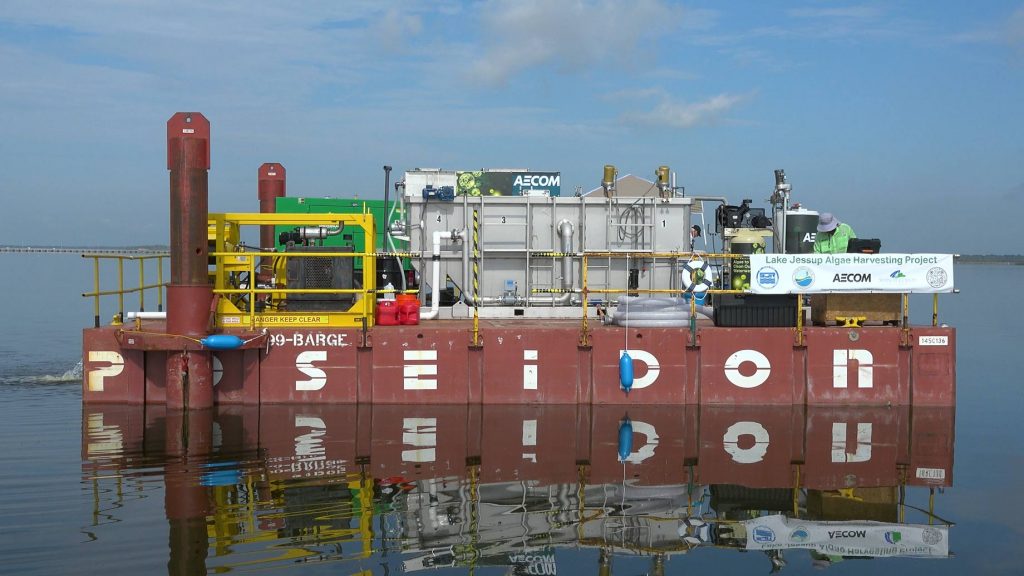Lake Jesup projects
Updated on 1-29-2025
Lake Jesup is a hydrologically complex system with a large, urbanized watershed and is the largest lake in Seminole County. The lake is shallow with a relatively low flushing rate that drains a 150-square-mile watershed, including portions of Oviedo, Sanford, Winter Park, Casselberry, Maitland, Longwood, Altamonte Springs, Lake Mary, Eatonville, Winter Springs and Orlando in Seminole and Orange counties.
Local stakeholder interest in restoring the lake began in 1993 with the Friends of Lake Jesup. In 2002, the District’s Governing Board designated Lake Jesup as a priority basin for restoration of water quality and fish and wildlife habitats. In 2008, in conjunction with the Lake Jesup Interagency Management Strategy, the Florida Department of Environmental Protection adopted a total maximum daily load for total phosphorus followed by the Lake Jesup Basin Management Action Plan (BMAP). As a result, progress is being made to reduce nutrient sources and concentrations to improve the lake’s water quality and clarity.
Lake Jesup Nutrient Reduction Project
Reducing the total nitrogen (TN) and total phosphorus (TP) concentrations in the water column is an important step for improving water quality in Lake Jesup. An analysis by CDM Smith in 2021 on behalf of the District determined that small footprint technologies, including media-based nutrient removal, could remove TN and TP from the water column at higher rates than a flow-through wetland system for a similar capital investment.
The goal of the Lake Jesup Nutrient Reduction project is to design, construct, and operate a nutrient removal system, using biosorption activated media-based technology, that cost-effectively removes TN and TP from Lake Jesup. The project will pump raw water from the lake, treat influent using media-based technology, and discharge water treated to state water quality criteria back to the lake. The full-scale treatment technology will be designed to remove TN and TP at rates at or above 50,000 and 5,000 pounds/year, respectively. The project location is a 9.7-acre upland property on the larger District-owned Lake Jesup east tract (see figure).
Design of the full-scale nutrient removal system began in January 2024. Part of the design work will be a pilot-scale study to evaluate the best media-based technology.
Project costs
- Total construction: $20–25 million
- Engineering: $1.1 million
- Operation and maintenance: $250,000–$400,000/year
Benefits
- Estimated total phosphorus reduction: 2,800 lbs./yr.
- Estimated total nitrogen reduction: 23,800 lbs./yr.
- Estimated increase in area suitable for submerged aquatic vegetation: 200–500 acres
Project schedule
- FY 2024–2025: Initiate design and permitting
- FY 2025–2026: Ongoing design and permitting
- FY 2026–2027: Complete design and permitting
- FY 2027–2028: Bidding and construction (contingent on funding)
Lake Jesup intact cellular algae harvesting with simultaneous nutrient export
- This pilot project, conducted by AECOM, deployed a mobile algal harvesting unit that removed nitrogen and phosphorus through direct removal of the entire algae cell (known as intact cellular algae) and suspended solids located within the upper 12-inches of the water column in Lake Jesup. An innovative air flotation technology was utilized to attach microscopic air bubbles to the algae and sediment floc, creating buoyancy, to allow efficient separation of algal biomass and clarified water. Clarified water was returned to the lake while algal biomass were managed at Seminole County’s Yankee Lake Wastewater Treatment Plant. The harvesting unit was mounted on a barge and transported around Lake Jesup so that algae could be harvested at various locations.
- The pilot project received $1.7 million, in 2020, through a Florida Department of Environmental Protection Harmful Algal Bloom Innovate Technology Project Grant solicitation requesting proposals from government entities to prevent, detect, cleanup, or otherwise address harmful algal blooms in Florida’s waterways. This was a direct result of the 2019 Blue-Green Algae Task Force, formed by Gov. Ron DeSantis.
- AECOM periodically operated the algae harvesting system over a nine-month period and completed system operations in May 2022. System decommissioning and removal from Lake Jesup was completed in November 2022. The objective of this pilot project was to collect representative data to evaluate system efficiency and the cost effectiveness of a full-scale system that can help achieve the Lake Jesup Total Maximum Daily Load and Basin Management Action Plan goals.
- See final report here.




